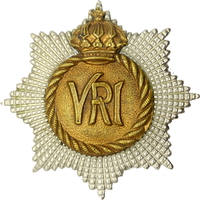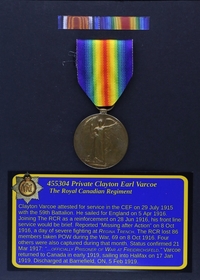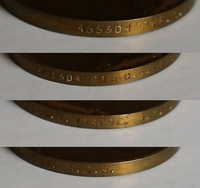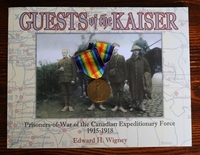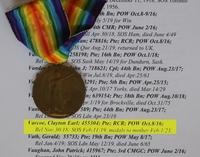
455304 Private Clayton "Earl" Varcoe
59th Overseas Battalion, C.E.F.
The Royal Canadian Regiment
By: Capt (ret'd) Michael M. O'Leary, CD, The RCR
Clayton "Earl" Varcoe was born on 25 Jun 1898 in Campbellford, Hastings County, Ontario. Varcoe's family can be found in the Canadian censuses if 1901 and 1911. In 1901, parents Thomas (41) and Ida (33), Thomas' second wife, are shown with five children; Jennie (17), Mable (15), Violet (12), Effie (19), and Earl (2). By the time of the 1911 census, only the three youngest children were still living at home.
Varcoe attested for service in the Canadian Expeditionary Force (C.E.F.) with the 59th Overseas Battalion at Cobourg, Ont., on 29 Jul 1915. A 17-year-old confectioner (who claimed to be a year older with a birthdate of 26 Aug 1897), Varcoe was described on his attestation paper as 5 feet 8 1/2-inches tall, with a 36 1/2-inch chest, a fair complexion, blue eyes, and brown hair. His religious denomination was Methodist. Varcoe identified his father, Thomas Varcoe, P.O. Campbellford, Ont., as his next of kin. On attesting with the 59th Battalion, Varcoe was given the regimental number 455304.
The 59th Battalion (Ontario), C.E.F., was authorized on 20 Apr 1915 and recruited in Eastern Ontario and Hull, Quebec, and was mobilized at Barriefield (now CFB Kingston), Ontario. The unit embarked for Britain on 1 Apr 1916, where it provided reinforcements for the Canadian Corps in the field until 6 Jul 1916, when its personnel were absorbed by the 39th Battalion.
Following training in Canada, Varcoe and the 59th Battalion sailed for England from Halifax on 1 Apr 1916. They arrived in Liverpool on 11 April. Soon after arriving in England, on 23 Apr 1916, Mercer was sent to the School of Field Entrenching at Bramshott. Two months later on 28 Jun 1916, he was selected as a member of a draft for The Royal Canadian Regiment and, having crossed the Channel, was taken on the strength of the Regiment in the field the following day.
Varcoe's service record has no notations for his first three and a half months service with the RCR. Through the summer of 1916 the Regiment followed the cycle of rotations in forward trenches, support trenches, and reserve positions that would characterize the infantry experience of the Great War. Between the start of July and early October, 1916, the Regiment would cycle through the forward line of trenches four times, each rotation being about four days between relief operations. Like many soldiers of the war, Varcoe's experience at the front was the steady cycle between trenches and reserve, without major incidents that necessitated entries in his service record.
It was on 8 Oct 1916 that Varcoe's war would change significantly. The names "Somme," "Ancre Heights," and "Regina Trench" are all applicable names for the actions on early October, 1916. The Regiment's "Battle Bar Document" (prepared after the war by the Militia Department in anticipation of the possibility of clasps for the British War Medal) provides the following details for 8 Oct 1916:
"8 Oct 1916
"4.30 a.m. – Bn in "jumping off" position.
"4.50 a.m. – Bn advanced to the attack on REGINA TRENCH taking objective and many prisoners. The objective was held for four hours, during which time 3 counter-attacks were repulsed. Owing to Bn on Left having failed to reach their objective Bn was compelled to withdraw in order to avoid being outflanked.
"10.00 p.m. – Moved to SUGAR TRENCH."
The War Diary of The RCR relates a day of severe fighting on as the battle raged for Regina Trench. The narrative of the battle states only 140 effective members of the battalion marched from the battlefield, the remainder having been evacuated wounded, were missing, or buried. The following day, after the Regiment moved to Tara Hill, the War Diary entry summarized the cost:
"9-10-16. – TRENCHES.
"Cloudy, not quite so cool. See Appendix No. 4. Total casualties reported to date are Captain SAPTE, Lieuts. SIMPSON, WALSH, SUTTON and PENNIMAN, Missing 8-10-16. Major HODSON, Major WOOD, Lieuts. DICKSON, DWYER, BELL and MURRAY, WOUNDED 8-10-16. Killed 7 other ranks. Missing 207 other ranks. Wounded 68 other ranks. It is expected that most of those reported missing will be located through slips from Casualty Clearing Stations as having passed through dressing stations of other regiments on our flanks."
Varcoe was reported "Missing after Action" on 8 Oct 1916. His next of kin would receive three cables regarding his fate as the official classification of his status evolved. The first cable, on 24 Oct 1916, stated "Missing since Oct. 8th, 1916." The second cable, on 27 Nov 1916, was "Previously reported missing, now unofficially Prisoner of War at Dulmen." The third cable, dated 21 Mar 1917, read "Previously reported unofficially Prisoner of War at Dulmen now officially Prisoner of War at Freidrichfeld."
The RCR lost 86 members to the German Prisoner of War camps during the Great War. 69 of those were captured on 8 Oct 1916 at Regina Trench. Four others were also captured during that month.
International Red Cross P.O.W. records note that Varcoe was suffering from a slight wound of his left arm when taken prisoner.
The 16 Nov 1916 edition of The Weekly Ontario carried a brief item on the death of Varcoe's brother-in-law that also mentioned Varcoe:
"Killed Seeking To Fill His Brother's Place.
"Campbellford, Nov. 8.—Lance-Corp. E. Doxsee, a brother of Lieut. W.J. Doxsee, who was killed in action in April, 1915, after making a heroic stand with the 2nd Canadian Battalion, has also been killed in action. Just the day before his wife received the message from Ottawa ing that her husband was killed, message came saying that her brother, Pte. Earl Varcoe, was missing. Lance-Corp. Doxsee was a veteran of the South African war. He enlisted here with the 59th Battalion after word was received here that his brother had been killed, and was transferred in England to the 2nd Battalion, his brother's regiment. He leaves a wife and two little girls.
At the end of the war, after two years and two months of captivity, Varcoe was repatriated to Ripon Camp in England on 30 Nov 1918. He returned to Canada in early 1919, sailing into Halifax, N.S., aboard the S.S. Olympia on 17 Jan 1919.
Varcoe was taken on the strength of the Casualty Company No. 3 District Depot and discharged at Barriefield, Ontario, on 5 Feb 1919. His last Pay Certificate shows an accumulation of pay totaling $677.30, a sizable amount for a soldier who was earning one dollar per day.
Five months after returning home, Varcoe died while boating and swimming on a vacation trip to Alberta. Details of his death were published in the Edmonton Journal edition of 12 Aug 1919.
"Two Soldiers Drowned in Lake Wabamum While out on a Holiday Trip
"Corporal George Potter Mysteriously Disappears While Bathing Near Fallis and Earl Varcoe Loses Life at Seba Beach.
"Corporal George Potter and Earl Varcoe were drowned on Monday at East Bay, Fallis, and Seba Beach respectively.
"Potter was the son of George W. Potter of 11533 92nd Street, and the possessor of a military medal with bar. On Monday morning he left with his mother and three young children for East Bay, where the party was to stop at the camp of W. Ward for a week. More guests arrived in the afternoon and Potter along with eight others went into the water.
"After a short time the young man was found to be missing and a careful search was made, Dr. Braithwaite who happened to be on the beach was summoned and after notifying the provincial police here, directed a further search in the water.
"Drowns With Rescuers Near
"The death of Varcoe was less mysterious as he drowned in full sight of a party endeavoring to rescue him. The accident occurred about Monday noon when the deceased went out some three hundred feet from shore in a boat where the water is about twenty feet deep at Seba Beach. After rowing around for a short time he dived from the boat. To those who were watching on shore he seemed to have some difficulty in regaining the craft which had drifted off with the breeze.
"When the people on the beach noticed he was in distress they put out in boats and strained every nerve to reach him and when one canoe was within ten feet of him he sank for the third and last time.
"Other boats were soon on the spot but every effort to locate the body was without avail.
"Varcoe and Potter had both been soldiers and had only been returned a short time.
"A Hero of the War
"Corp. Potter enlisted at the age of eighteen with the 66th battalion in the spring of 1915 but was later transferred to the 63rd battalion. Some time afterwards he went to France with the 8th Winnipeg battalion and was made a corporal. He was wounded in the leg in August 1917 and received a Military Medal for bravery. This was afterwards supplemented by a bar for gallantry in action.
"He was the second son of George W. Potter, an instructor in the forging branch of the technical school and was temporarily employed with the E.C.D., while awaiting the recommendation of his application for vocational training.
"Was on Visit Here
"Varcoe was the son of Thomas Varcoe of Campbellford, Ontario, and was visiting his cousin, Roy Kingsley, of 1437 94th Street, with whom he had gone to Seba for the week end and was staying at McCart's cottage.
"He had only been in Edmonton two or three months and was working here for the Marshall-Wells Ltd.
"The deceased was a member of the overseas force and had spent two years and nine months (sic) as a prisoner in Germany."
In the Registration of Death record held by the Archives of Alberta, Varcoe's occupation was recorded as "expressman" (i.e., packing, managing, and ensuring the delivery of cargo). Varcoe's remains were returned to Campbellford, Ont., for interment.
For his service in the C.E.F., Varcoe was entitled to receive the British War Medal and the Victory Medal. These were despatched to his parents at Campbellford, Ont., on 1 Feb 1923.
Pro Patria
Visit a randomly selected page in The O'Leary Collection (or reload for another choice):
- The O'Leary Collection; Medals of The Royal Canadian Regiment.
- Researching Canadian Soldiers of the First World War
- Researching The Royal Canadian Regiment
- The RCR in the First World War
- Badges of The RCR
- The Senior Subaltern
- The Minute Book (blog)
- Rogue Papers
- Tactical Primers
- The Regimental Library
- Battle Honours
- Perpetuation of the CEF
- A Miscellany
- Quotes
- The Frontenac Times
- Site Map
QUICK LINKS
The O'Leary Collection—Medals of The Royal Canadian Regiment
Newest additions:
![]()
![]() SB-12725 Private Henry "Hank" Ard
SB-12725 Private Henry "Hank" Ard ![]()
WIA at Hill 187, Died of Wounds in Japan
![]()
![]() 2355331 Lance Corporal Albert Lorking
2355331 Lance Corporal Albert Lorking
Wounded in action, later a War Amps representative.
![]()
![]() 4334 / 477996 Pte Isaac Hamilton Wilcox
4334 / 477996 Pte Isaac Hamilton Wilcox
Permanent Force, South Africa, and C.E.F.
![]()
![]() 477019 Private Harold Ashcroft
477019 Private Harold Ashcroft
Transferred to the Tunnelers.
![]()
![]() 734231 Private Clark D. Thompson
734231 Private Clark D. Thompson ![]()
The older Thompson brother, killed in action.
![]()
![]() 733849 Private Norman Parker Thompson
733849 Private Norman Parker Thompson
The younger Thompson brother; post-war service in the Special Guard.
![]()
![]()
![]() A305 / 400305 Private Andrew Walker
A305 / 400305 Private Andrew Walker ![]()
"Previously reported Wounded, now Killed in Action."
![]()
![]() 823298 Pte Thomas Patrick Steele, M.M.
823298 Pte Thomas Patrick Steele, M.M. ![]()
… for gallant conduct in the field …
![]()
![]() P13066 Sergeant Harold Thompson
P13066 Sergeant Harold Thompson
Instrumental Soloist for over 20 years of Canadian Army service.
![]()
![]() 9609 / 477728 Private Albert Edward Piper
9609 / 477728 Private Albert Edward Piper
"Arrived from England as a STOWAWAY …"
